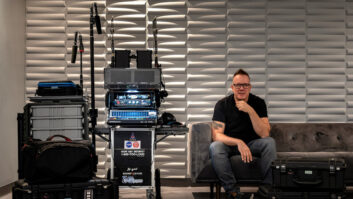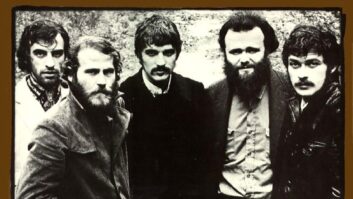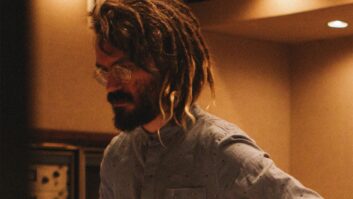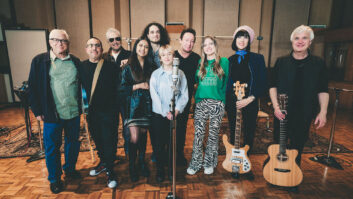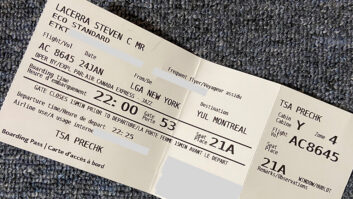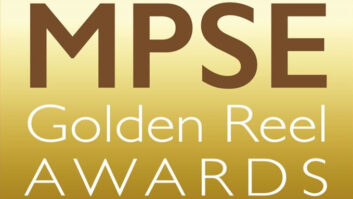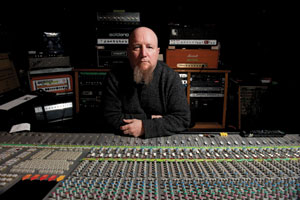
With nearly eight decades of experience between the two of them—including seminal projects for Rage Against the Machine, Red Hot Chili Peppers, Metallica, Van Halen, Aerosmith, AC/DC, and Biffy Clyro, as well as a number of Juno Awards—Garth “GGGarth” Richardson and Mike “The Fraze” Fraser are two of Canada’s finest, most well-respected producer/engineers. This month, Mix sat down with them to discover the stories behind their careers, how some of the magic behind the music was created and some of their go-to recording and mixing techniques.
Let’s start with how you got started.
Richardson: I started hanging around my father [producer Jack Richardson] in the studio at the age of five. He was doing a session with Bobby Curtola for Coca-Cola at a studio called Hallmark in Toronto. This was my first time being allowed in a session. I soon found out what the talkback button was, and, when he was out on the floor, I would keep hitting it, and…well, let’s just say never get Jack mad. Never have I seen a man run so fast to come up and tan my backside! I hid in the tape vault. The engineer felt so bad, he gave me my first reel of tape. That’s probably when I first got the recording bug. At age 14, I became the janitor at Nimbus 9 Studios. My fake company was called Gar Janitorial Services (Bob Ezrin named the company). I would sleep at school all day, go and clean up the pee and puke in the bathrooms, and then sit in on sessions all night long.
My first engineering gig as a second engineer was on Bob Seger’s Night Moves. My father was asked to do four songs with Bob, but he only had two. They did a cover song for the third. After the tracking, Jack sent the band home and started to mix. Later, Jack fetched Bob to hear the mix and heard him playing this song “Night Moves,” and Jack said to Bob, “this is a hit.” Bob said he hated it. I happened to be there, and I got to set up the room and watch them record this song as a second engineer. I was hooked.
When I was 18, I sat in on the Peter Gabriel record [called Peter Gabriel] that was made at Nimbus 9’s soundstage recording studios. The band kept saying to Bob Ezrin, “who is the kid?” But Bob let me sit in. I would sit in the corner in front of the console, and if any one needed smokes, food, or anything, I would run my ass off to get back; I did not want to miss a thing. It was all live off the floor.
I got to hang out with the Bay City Rollers, Alice Cooper, the Guess Who, and I even worked on a John Denver session.
My father asked the Rollers to come for a swim at our house. Two neighbor girls saw them get out of the car, and within an hour, 500 screaming girls surrounded our house. Jack took out the garden hose, hosed them down and scared them away.
I was [my dad’s] runner at first. They had a rule in the studio—if you couldn’t bring food properly into the control room, you were not allowed in in any other capacity. This is how we still start the training in studio. I got to second-engineer for my dad a few times, but I was never an engineer for him.
On one session we were mixing, I was running the ¼-inch machine—master mixes at 30 ips and TV mixes at 15 ips. I would cut out the mixes and put them onto the master reel and TV reel. At one point, I messed up and recorded the master mix at 15 ips. They had already moved onto the next song. I think I shit my pants. How was I going to get out of this one? So I told my dad’s engineer that I was not happy with the tones on the 2-track machine, and I needed to bring in another machine to check. I set up the second machine to 15 ips and copied the master over to 30 ips. Jack never found out what I did.
We ended up doing a few co-productions. My first record with him was [American blues rock band] The Numbers on Attic records. And the second one was [Canadian heavy metal band] Sword. Whenever he would look over his glasses at you, you knew you were in trouble. He commanded excellence. He was always the first guy on the session and the last one to leave. This was a very big part of his molding me.
When I told Jack I wanted to produce records, he said he needed to have a sit-down with me. I was waiting for this long talk on how to make it in the music-production biz. He put his hand on my shoulder and said, “Son, good songs sell, bad ones don’t.” I said, “That’s it?” He said, “Yeah,” and walked out of the room. It’s still true to this day, and I tell that to artists all the time.

Mike Fraser
Fraser: I was in a garage band while I was in school. It was pretty obvious right away I wasn’t going to make a career from that, so after a couple years driving trucks and heavy equipment, I decided to look into the music business as a career again. I managed to get a janitor job at a local Vancouver studio called Little Mountain Sound. At that time it was mostly a jingle house. After doing my janitor duties, I would help set up the day’s sessions and assist the in-house engineer—Roger Monk.
At the time, Bob Rock was a budding engineer there, and in the evening, he would record local punk bands. So naturally I asked Bob if he’d like some help. My typical day ran from 5 p.m. to 2 a.m. I had a sleeping bag stashed at the studio, and would crash in the loading bay or whatever empty room was available. Sometimes it was the boardroom of GGRP—the jingle company upstairs. Occasionally I’d wake up to a boardroom meeting in full session. I basically lived in the studio for a year and a half.
Bob soon after teamed up with Bruce Fairbairn, and I ended up being Bob’s full-time assistant. Starting with a Canadian band called Prism, that record eventually led to Bruce signing on to produce Loverboy, which led to Bon Jovi, which led to Aerosmith, AC/DC, etc. And the rest is history.
Roger Monk was a very big influence on me, and trained both Bob and I. He was very good at recording to tape and recorded the levels in a way that you’d want everything to sound in the mix later. When you mixed one of his sessions, you could pretty much bring up all the faders to zero and the mix would be there. He really paid attention to how an instrument sounded out in the studio, so when he put a mic on it, he could replicate that exact sound he was after.
Roger was a minimalist and taught me that simpler is often better. Short signal paths, less EQ, compress only when you need to or as an effect. I still try to carry that basic lesson with me.
Mike. For me, your most famous work is with bands like AC/DC, Aerosmith, Van Halen, Slipknot, Thunder, Rush and Metallica. How do you go about creating such a dense and massive sound and yet manage to keep everything clear and loud?
I think it’s back to the basics of keeping things simple. Listen to the instrument you’re about to record, and determine what it is you’re trying to get out of it. Find the sweet spot of where that sound is coming from, and stick a mic there. That’s all there is to it. Yes, of course there are a lot more subtleties to recording, but if you don’t even get that basic idea right, you’re making things too difficult.
The next thing you have to be aware of is where in the sound spectrum each instrument will be placed. The bass will be low frequency, the drums will be low to ultra-high, and guitars and vocals will be mid-range. You’ll need to make sure the bottom of your bass and kick drum complement each other and work together, not against each other. If you’re adding 50 to 60 Hz to both instruments, you’re going to get a giant build up in that area and won’t be able to get any definition. Always check the phase and make sure they are in with each other—that’s very important!
The snare sound is usually mid spectrum, so be careful the vocals and other instruments with that frequency work with it. The cymbals are your top-end spectrum. I try to get the cymbals so they have a nice sheen on them, and not too harsh, but at the same time you don’t want them too airy and with no substance.
Guitars are a tough one to get. Big, loud, distorted guitars take up a lot of room. For me, this is where the less-is-more trick can really help you out. For example, don’t always double all your guitar tracks. Try using as few guitar tracks as you can. I know initially they sound bigger and fuller while you’re doubling them, but my thought is to just work on the sound a little longer and go with the one track. Or when you do double, change up the guitar and amp you’re using; that way you don’t get a build up of the same sound.
Garth. Some of the work you are most known for—Rage Against the Machine, Red Hot Chili Peppers and Biffy Clyro—can come across as pretty heavy but still with a big commercial sound.
I try and make each band sound like themselves. This again goes back to making sure everyone is playing the right parts and making sure the sound in front of the mic is always great. I don’t want the same painting in every room. A lot of producers have that.
Some people like to start from the drums up, others like to throw up all the faders and sculpt away from there. How do you start a mix?
Fraser: I like to do a combination of that. I usually throw up the faders and see where the song wants to go and try to get a picture of what the artist and producer were going for. Then I strip it all down and start from the drums up. Depending on the genre of music, I like to get the vocal in there pretty early on and build around that as well.
Richardson: Mixing engineers were called balancing engineers in the old days. Before the dawn of Pro Tools, engineers would record a session such that you only had to set your faders at zero and the session would be properly balanced. Then you only had to adjust some faders slightly. These days, with all the tracks and plug-ins, you’ll see faders all over the place on the mixing console. It’s the Wild West out there. Too many people reach for plug-ins and EQs just because they are there. If it were possible to put 60 plug-ins on a track, people would do it!
It’s gotten to the point where, at our studio [Fader Mountain], we have had to introduce two separate fees for mixing. One is a fix-it fee, where we get the session ready to mix, and one is a mix-it fee. For example, I find that few engineers are able to commit to one guitar sound. They will have four mics on one cabinet, and each mic will be in a separate track in Pro Tools. As mixers, we then have to blend these four tracks down to one track. If you have eight rhythm guitar tracks with four mics on each, that’s 32 guitar tracks where, for mixing, there should only be eight. This takes a lot of time and costs money, and as the producer, I don’t want the second engineer to choose my sound for the mixing engineer. I have seen this happen, but not on my records.
How do you mix vocals? Do you have any must-have gear in your vocal chain?
Fraser: Vocals are one of the most important parts of the mix. For a song that’s a little more pop or country, vocals need to be louder than anything else, but in a way that doesn’t make the backing track sound small. Compression is your friend. The problem with over-compressing is you will suck all the dynamics out of a performance. So I like to set up a side vocal bus that is squashed and EQ’d with a lot of middle. Then I add that into the main vocal channel as I need to, to make the vocal pop. For that, I like to use the 1176 black face. I love the sound of it, and that’s one of my main go-to compressors. On the main vocal channel, I like using the Empirical Labs Distressor. It’s a very versatile compressor, and with a minimal amount of work, you can get it to do a lot of tricks. For vocals, I like a 4:1 ratio, medium attack and a quick release.
Richardson: Again this all starts on how you record the vocal. I like to set up many mics for the singer to try: Shure SM7, AKG C414, [Electro-Voice] RE-20, Neumann U 87 and U 47, and a Shure SM58. Once we select the right mic we then pick a mic pre: API, SSL, Neve. Then I choose a compressor. My fave is to have two [Universal Audio] LA-3As in a row, the first one on limit—20:1—and the second one on compress—4:1. When tracking the singer, I may have them in the control room with me, both wearing headphones. I spend a lot of time working on parts and getting the singer to sing as much in tune as possible in order to have to do as little comping and Autotune as I need to.
My favorite compressor for mixing on a vocal is the ADR Compex F760X-RS Analogue Compressor. It makes the vocal dirty, and when you put it in the mix, it pops through the mix and puts it on top.
Do you have any favorite mics and tricks for recording drums?
Fraser: On drums, I mostly use [Shure] SM57s and Sennheiser MD 421s. Over the years, I’ve become more of an “over-miking” guy. Two top mics on the snare—SM57 and C414—plus a 57 for a bottom mic. On toms, I always have a top and bottom mic: the 421 and 57. I had a special mult box built with 2 inputs and 1 output. With miking the top and bottom of a drum, the bottom mic will always be out of phase, so I had my mult box made with one of the inputs reversed. With the box, I can have up to 10 mics on the toms, but only 5 outputs.
Phase is very critical when you’re multimiking. So I am always checking and rechecking the kick-snare relationship to the overheads, room mics and even within themselves. You’ll have a ton more punch if everything’s in phase.
Garth, I remember that on the Gallows [hardcore punk band from England] record, you had top and bottom mics on the toms. Is this a technique you use all the time, or does it depend on the material?
For that particular session with the Gallows, yes, we did it that way. By miking the top and bottom toms, it gives you a deeper sound. You must always flip the phase on the bottom mic. I have done everything from miking with no bottom heads on, which was big in the ’80s, to the Glynn Johns’ miking method, which is two Neumann 47s—one above the kit, one right of the floor tom—and a [AKG] D12 kick mic. Johns is a god when it comes to drum sounds.
For The Melvins Stoner Witch record that I did with Joe Barresi, we had three kits set up. One had 40 mics and a full-blown concert P.A. Across from that kit, we had another kit set up with eight tube mics. We had a third kit in a small room with two overhead mics, one mic in the kick, a mic on each tom, and one mic on the snare. It gave us a great selection from which to choose. We would hear the song and then pick the kit we wanted. It was a lot of fun.
Here’s a tip: bad drummer equals bad drum sound. I worked with Jeff Porcaro of Toto once, and when he walked in and set up his kit, the heads looked old and the kit looked tired. But it took us only five minutes to get a great drum sound. It was a real joy to work with him. So it goes to show, great drummer equals great drum sounds.
Sometimes I will have my drum tech set up the kit, and we’ll have a great sound. Then the drummer from the band goes in and plays, and it sounds terrible. Tech goes back and checks and plays for me, it sounds great. Drummer goes back, sounds terrible. Are you catching my drift here?
How do you get a distinct, clean, powerful bottom end?
Fraser: Bass for me is almost a bit like a vocal in that the approach you take very much depends on the style of music. There can be clean, upfront-sounding bass tracks, or more super fuzzed-out basses that sit back in the track, and everything in between. The bass bottom end needs to match and complement your kick drum, as well as stay out of the way of the lower guitar range. Compression can help a lot, but again, too much can suck dynamics out of the performance, so you need to be careful and dial the compression in for exactly what you’re looking for. The Fairchild 660 and 670s are awesome for this.
Richardson: Again this goes back to how a speaker works. The bottom end—the kick, bass and the bottom end of the guitars and any keys that are playing in that range—must all be in tune and hitting at the same time. This way, the speaker moves the way it should. Everything is pushing and pulling at the same time. Phase is a big thing, too. That phase button on every console is your best friend. Moving mics on a bass cab back and forth in front of a speaker can make a world of difference, too. We use the Little Labs Phase box a lot. That is a must-have in your engineer toolbox.
Another thing that we do regularly is test cables. Cables sound better going one way than the other. Plug in your cable on your bass, and then switch it the other way and you will hear a difference. One way will always give you better bottom end. People tell me I’m smoking crack when I say this, but then I show them, and it blows them away.
Mike, guitar-wise, are you an SM57 guy, or do you go crazy with various cabs and heads and a selection of dynamics, ribbons and condensers?
I like SM57 and Sennheiser 421s on each cab. I’ll throw an AKG 414 on, as well as a “room mic,” but I won’t always use it. I do like to use different heads and cabinet combinations while looking for a certain sound, but I don’t often use a multiple combination of heads for a single sound. I’m a minimalist when it comes down to it, so I like to work a bit harder choosing the right head/cab combination with the right mic combination and placement. For me, less is more.
Coming back to the Gallows project, Garth—I was recording a very acoustic project in RAK Studio 2 [London] at the same time you were working on the Gallows project, and I distinctly remember having to stop recording a few times because you guys were setting up guitar sounds that made the entire building shake. During a break, I wandered into control room No. 1 and saw the biggest collection of guitar amps ever. I’ve since spotted similar setups on some of your Facebook images from recent sessions. Could you tell us a little more about that process?
[Laughs.] When I was the engineer on Mother’s Milk by the Red Hot Chili Peppers at Ocean Way studio in L.A., we shut down three studios in the building because of the level of Flea’s bass. My response to their complaints is generally to let them know what key we are in, so if they want to play along, at least our bleed into their session will match in tuning.
The Gallows record was one of the most intense records I have worked on in a long time. I wanted an analogue sound for this record. Everything was touched by tape on this record. We would track the bass into Pro Tools, fix it in spots, then re-amp out to the bass amps using a Little Labs PCP Instrument Distro Box. We would match the sound we had, then record it to tape and then back into Pro Tools. We did the same for every single guitar part. When I tried to explain this method that was in my head to my long-suffering engineer Ben Kaplan, he just looked at me and shook his head. We got into a flow, and it all worked out in the end.
As for stacks of heads and cabs, we make a chart of every head and cab and spend a day playing each head into each cab and marking down the best parings. Each head has its own sound, and every cab has its own sound. We spent a lot of time finding what worked best for Gallows. We also spent a lot of time checking phase on all the cabs. When using lots of cab, phase is your friend. In-phase is good; out of phase is bad. My dad was the first person to have a guitar splitter built. It was made by a person named Kirk Elliott at Phase One Studios. I still use the guitar splitter today. This is how we get the great guitar sounds.
I remember seeing a picture of Mike with some mad vintage military-style limiter. What can you tell me about that beast?
That beast is my RCA BA-6A compressor. I believe it is a ’50s-era radio station compressor. When I worked with Jimmy Page on the Coverdale-Page record, he had brought in a bunch of them in, and I fell in love.
Jimmy was saying that Led Zeppelin III was mostly recorded through the BA-6As, so I had to get a pair. They work great on just about anything, from room mics to guitar solos. They are a bit of a one-trick pony, as you can only adjust the input and output levels, so they either get the sound you want or they don’t.
Garth, I understand you set up a full-blown P.A. system in the live room to record the self-titled Rage Against the Machine album.
Working on the RATM record was a blast and a lot of hard work. This was before Pro Tools was being used. I went to see them live and was blown away by how great they were. As a producer, I did not want to just take them into a studio, make them wear headphones, and then say “rolling.” I wanted to make it like a live show. I had rented a Meyer P.A. system and set it up with Brad [Wilk, drums] behind it. Tim [Commerford, bass] and Tom’s [Morello, guitars] amps were in the back rooms at Sound City. Zack [de la Rocha, vocals] used a Shure 58 for his vocal. I had the whole band blasting back through the P.A. while they were playing. Once again, I shut down Studio B at Sound City…are you seeing a pattern here? [Laughs.]
We tracked most of the record live and did a few fixes along the way. On the song “Settle for Nothing,” Tom wanted to redo his solo. If you listen carefully to this song on the record, because we recorded it live, you can hear the old solo bleeding through the drum mics. It sounds like a tape echo. We got lucky.
Andy Wallace did a great job mixing this record for us. When recording a band, it’s important to understand who they are and remember that they are human. It’s not a spec sheet for a robot. As I tell our students at Nimbus School of Recording Arts [which Richardson co-founded with Bob Ezrin and Kevin Williams], “Don’t be a enginEYE, be a enginEAR.” Take risks!
Mike, most people see you as a hard-rock/metal engineer, but you have credits such as Franz Ferdinand, Norah Jones, Colin James, Bryan Adams and Elvis Costello under your belt. Are there genre-specific techniques you use, and how easy is it to get into that different headspace when you work?
Working within different genres is fun as it keeps you from getting into a rut. But it can really mess with your head. For instance, what works with a classic-rock band—lots of room on the drums, lots of effects on everything—does not work with a more alternative type of band, where everything dry and up front. So the mixing focus will have to do a complete 180.
This past week, I went from mixing AC/DC to mixing a Cancer Bats record, and then mixed a more pop/singer-songwiter type guy called Kyle Richardson—three completely different genres right in a row. What works for me as far as headspace goes is to trust my instincts and go with what I think works best for the song.
You’ve also been doing quite a lot of surround work. What about the rear channels? Should there be anything in the .1 channel, and where do you see the multichannel format end up?
Surround mixing is fun, but for rock music I think it only really works for live recordings. When I’m mixing a live surround session, I basically try to make it a “super-wide” stereo mix. The listener is looking at the stage, so that’s where the sound focus is coming from. I don’t want to be watching a live DVD of a band, and all of a sudden be hit in the back of the head with an acoustic guitar part. It’s like the guy in the row behind you all of a sudden deciding to join in. It doesn’t make sense to me.
I put drums in front L and R only. The other instruments I will place Front L and R, and then add a tiny bit of them to the rear L and R so that it “pulls” the focus of them out a little wider. I’ll place the lead vocal in the front L and R, as well as a touch in the center speaker. I’ll put bass, kick and any other low-end instruments in the sub channel.
The rear speakers—other than using them to help widen the sound—I reserve for audience and room mics. I try to make the listener feel like they’re right there at the show.
Surround formats are different because of where most people do their listening nowadays. Earbuds and computer speakers are more the norm, and I think the surround format is best listened to when you’re a captive audience, like sitting on your couch watching a live show, or in your car.
What are some of your current projects?
Fraser: I’ve just finished doing a new AC/DC record with Brendan O’Brien producing. It’s the same team we had on the Black Ice record. We had a lot of fun doing it, though Malcolm [Young, rhythm guitarist for the band, who is currently on leave due to ill health] was missed terribly.
I’m heading off to Poland for the month of August to record with a band called Chemia. In September, I’m in London mixing for my long-time buddy’s band, Thunder.
Richardson: My next project is a band from Finland called The Von Hertzen Brothers. I am currently working with a few bands: Ninja Spy, The Washboard Union and Wolfborne. Bob Ezrin just mixed a record for me: the band Gloryhound coming soon on eOne. I’m also starting work with a band called The Lazys, from Down Under. They sound like Guns ‘N Roses meets AC/DC.
Garth, can you tell us a bit more about Nimbus and your new studio in Vancouver, Fader Mountain Sound? And finally, what project are you most proud of and why?
This last question ties everything together. This is why Bob Ezrin and I opened up Nimbus School of Recording Arts. Bob and I both felt that the students coming out of the audio engineering schools today did not possess the kind of skills that we needed in order to put them directly to work in the studio. How we were trained was not how they were being trained. We needed to change this. So the doors of Nimbus opened. Our goal is to help students find their way in this new music world, and at the same time instill in them this spirit of excellence. My father showed Bob the ropes, and then Bob used them on me—I’m joking. [Laughs.] We are now demanding this same standard of excellence from students at our school.
We like to think of the Nimbus environment as a bubble. If it breaks, nothing changes for them. They are in the real world at our school. They use the same gear and setup and work with artists, engineering and producing as they would in any studio. We now have our own record label called Business Class Records, run by our students. Great things are happening at Nimbus and we are so proud of our school.
Garth Futcher, one of our instructors at Nimbus (yes, Garth with only one G), came to me with a band from Chile called The ReAKtion. He showed me their video, and I was blown away; I agreed to help out. We were fortunate to have the opportunity to involve our students at Nimbus in this project. A big part of Nimbus is for our students to get hands on with real-world training. So they did a lot of the recording. We stand over them, like my father and Bob Ezrin used to do with me. I then traveled to Chile in March to finish the project. It is being mixed by Ben Kaplan, a nominee this year for the Juno named after my dad [Jack Richardson Producer of the Year] for his work on the Mother Mother record.
We took over Little Mountain Sound about two-and-a-half years ago, with five partners; we call it Fader Mountain Sound (We couldn’t get the Little Mountain Sound name). The whole idea behind it was we wanted to get people out of their bedrooms and back into a space where people shared ideas and hung out. It used to be that you would come out of your studio and see all your friends, and you would talk for hours about gear and the tricks you are doing on whatever record you’re working on at the time. This is no longer happening. We hope to change this; we have the right mix of people there to make this happen.
My studio is The Farm Studios at Fader Mountain Sound. I recently purchased Danny Elfman’s 72-channel SSL from him; I hope some of his magic came with the console.
I’ve also taken over the old Little Mountain Sound Studio A. It is a rehearsal space now, called The Vancouver Rockspace. Our dream is to eventually return the A room to its former glory. I know this would make Jon Bon Jovi happy.
I saved the hard question for last: What project are you most proud of and why?
Richardson: The Rage record because it changed the world, and it had a voice for the youth; all three Biffy Clyro records because they are so musical and smart, and they are the best bunch of guys (I turned them into hockey fans, too); and Mudvayne LD-50 because it is one of the best-sounding records I have done in that style. Best bass sound ever, in my mind.
Fraser: I don’t honestly know if I have a favorite project. Most of them I have very fond memories of, with some great laughs and stories. I feel very lucky to have worked with so many talented and awesome people over the course of my career, and I feel truly blessed. I still wake up in the morning and pinch myself to make sure it’s not a dream.
Wes Maebe is a London-based engineer/producer/musician. Check out his work at www.wesonator.co.uk.

